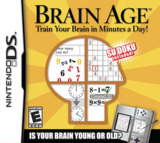A no-brainer
The primary objective of Brain Age is to “exercise your brain”. This is done through doing activities that are designed to stimulate your prefrontal cortex, which is the part of your brain that influences how you apply what you’ve learnt (whatever). It’s believed that doing these activities on a regular basis will have a positive effect on your brain. Whether or not this holds any truth, I’m not sure. But with 15 activities to choose from, at least the game can keep you occupied for quite a while, even though some of these activities are less desirable to do than others.
Some of these activities include a calculation game, which puts you through a series of simple mathematical problems. 2+6, anyone? Or 8x7, for that matter? Well, you get the picture. The idea is basically to get the brain to start thinking quickly with a succession of simple questions, instead of forcing the player to spend too much time dwelling on one. There’re different variations of this calculation module, but the underlying gameplay doesn’t divert from the idea of rapidly solving a problem.
Reading aloud is another activity in Brain Age. Obviously, this makes use of the DS’ mic, and it basically requires you to read through an article as quickly as possible. While you may have problems pronouncing words like “epoch”, you can actually breeze through this activity by simply bulldozing through without pronouncing the words properly. Just remember to wipe the saliva off your DS screens. Counting syllables is another mini-game on Brain Age. This one requires you to count the number of syllables in a short sentence, and then write the answer down on the touch screen. If you’re not exactly sure about what is a “syllable”, just remember that the word “syllable” itself has three syllables, and you should be fine.
Of course, there’re more to just calculation, reading aloud, or counting syllables in Brain Age, but as you can see, the activities in the game are not exactly the “saving the world from an evil force” kind. Yet, the game’s appeal comes in the form of its simplicity. At times, when playing this game, I feel like I’m doing one of those online IQ tests, and the eagerness to score well is impetus enough for me to keep going despite the dryness of the questions. This basically sums up the charm of Brain Age.
To spice things up a little, Brain Age also included a substantial amount of Sudoku puzzles. Now, if you can believe my wife, Sudoku is the best thing on Earth since sliced bread. The popularity of this grid-based puzzle game is immense, and it’s not surprising to see it being included in the game. As with the usual Sudoku books, the Sudoku puzzles in Brain Age are sorted according to difficulty. The easy ones are, well, pretty easy to solve, while the advanced ones require more logical thinking. Anyhow, Brain Age contains more than 100 Sudoku puzzles, which should keep fans of Sudoku occupied for quite some time. Having Sudoku as one of the 15 activities in Brain Age basically provides additional value for an already value-for-money budget game.
And, to top it up, Brain Age also has a multiplayer mode, which allows you to host up to an amazing 15 players with one cartridge. Unfortunately, the only playable activity in this mode is the calculation module, which lets you take on others in 30 mathematics questions. This gets old really quickly. It’d be fun if you can challenge your friends to a game of Sudoku (duh!), really.
Brain Age also requires a unique way of playing. You play it with the DS being held vertically, much like reading a book, with the touch screen on the right. The concept is to recreate the scenario of solving puzzles in a puzzle book, and to a certain extent, this blends in very nicely with the objective of the game. And, true to the game’s out-of-the-box nature, Brain Age is played entirely with the DS’ features. That is, via the touch screen and the mic. These make the game more “book-like” than the usual DS games. The game also caters to left-handers. If you’re a leftie like me, simply tell the game so, and you can turn the DS “the other way round” so that the touch screen switches to the left. This is a nice touch, or the game may just lose a lot of potential buyers!
The problem with how the game plays, however, lies in the sensitivity of the touch screen and the mic. Somehow, it seems to have problem registering my pronunciation of “black”, and doesn’t really recognize my “8” on the touch screen properly. As a result, I’ve an initial brain age of 76 (!) because of unnecessary errors. It appears that players will need to adapt to how the game receives input to do well in their own results. This is not exactly a big issue, but it could be frustrating when you’re trying to beat a certain timing, only to be let down by your poor handwriting or diction.
In conclusion, Brain Age is a very different sort of game, even by the DS’ selection of quirky titles. It may not boast the usual features that sell a video game, but in their place, we’ve something that is simple, unassuming, and ultimately very addictive. Moreover, the game is supposed to improve the functionality of your brain, so what’s there to lose? Brain Age is highly recommended.

